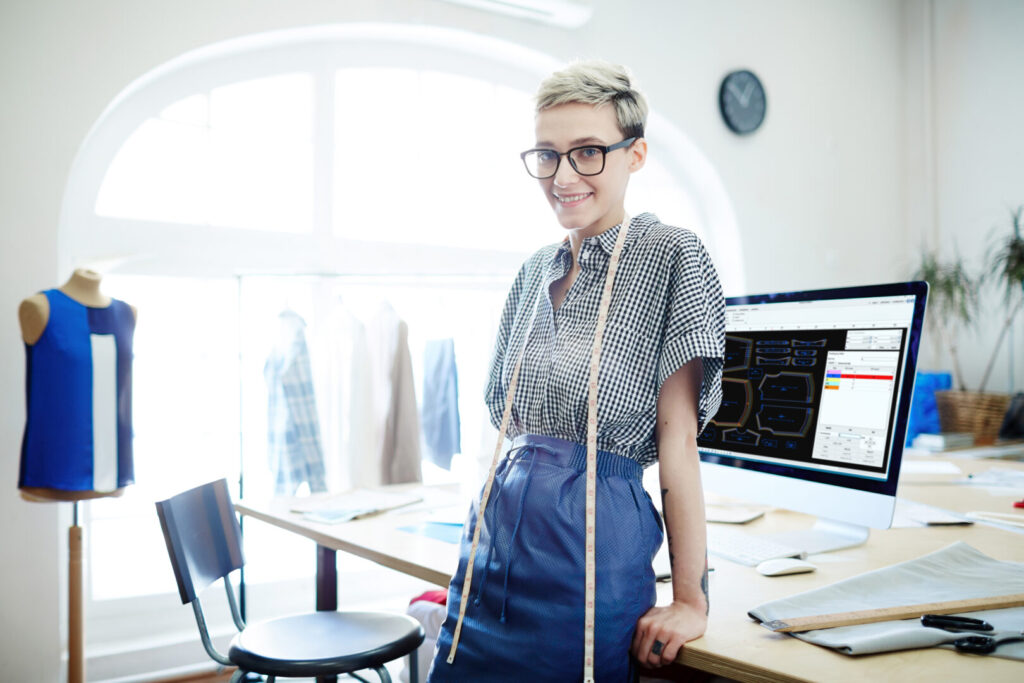Summary
- Fabric yield can directly impact your company’s profits
- By performing a calculation, you can understand the amount of fabric you need to make pieces for your collection
- Try creating the pattern for your collection in a 3D environment for free with Audaces360 multisolution!
Not always monitored, fabric yield is an activity that can significantly impact the costs of your clothing production.
One of the main problems in the textile industry can be present when it comes to your fabrics: waste.
If you understand the yield of your fabrics, you can use them more efficiently and thus achieve more profitability.
Read the text and learn more about the practice. Enjoy your reading!
Sumário
Why is it important to measure fabric yield in your clothing production?
An important factor for the manufacturer to know the exact amount of knit fabric to buy for production is to know the yield of kilograms of fabric in a quantity of pieces.
This conversion to know fabric yield is essential to have several benefits in your production.
Firstly, you can avoid waste in the production process by using and buying the exact and necessary amount of raw material.
This leads to greater savings and lower production costs. Besides having stock predictability, there’s no need to stop production due to a lack of products or even create unnecessary stocks.
Learn more: What is industrial quality control in the textile business and how does it work?
What is fabric yield and what is needed to measure it?
Fabric yield is nothing more than the calculation you make to find out how much fabric you have that can be transformed into garments.
To make this calculation, you need to know the amount of fabric and the pattern pieces, because it’s from their sizes that you’ll arrive at a final value.
With this calculation, you can reach the exact value used for each of the production items.
Learn more: Types of fabrics: List from A to Z
How to calculate fabric yield in your production?

Each fabric has its unique characteristics, and this is very important for those who want to calculate fabric yield.
For this reason, it is important to know and identify the characteristics of the fabrics that will be used.
Through the information obtained, you can determine which accessories to use for sewing and other important decisions for the process.
One of the most important pieces of information for this process is the grammage. It usually comes attached to a label along with the material.
If the fabric manufacturer did not provide this information, don’t worry. You can calculate the grammage using a formula, which is the relationship of the fabric weight per square meter.
With this calculated grammage or the one the manufacturer sent, you can classify your fabric as light, medium, or heavy.
Check:
| Grammage | Classification |
| g/m² < 130 | Light |
| 130 < g/m² > 220 | Medium |
| g/m² > 220 | Heavy |
Some manufacturers provide the average yield of knit fabric. As an example, we present the table from the Lycra company:

Other suppliers use the following formula for fabric yield calculation:
Linear yield (LY)
Indicates how many meters are in a kilogram of fabric (m/kg) and is calculated as follows:
LY = [1 / (Total width + Grammage)] x 1000
- Grammage: the number of grams per square meter (g/m²) of the knit.
- Total width: if the fabric is tubular, multiply the width by 2.
Example: calculation of linear fabric yield with the tubular width being 0.88 meters. The total width would then be 0.90 x 2 = 1.80 m.
Technical yield (TY)
Indicates the available area in a kilogram of fabric (m²/kg) and is calculated as follows:
TY = (1 / Grammage) x 1000
How can technology speed up this calculation for you?
Choosing to calculate fabric yield may seem like just another production task. But, of course, technology can be a great help to your manufacturing.
There are several various types of software that can assist in this task by collecting data such as grammage, kilograms, and patterns of pieces.
Automating the process makes it easier and simpler to perform, quickly and efficiently, optimizing time and bringing concrete results.
Learn more: How can fashion brands boost their business with technology?
Calculate fabric yield and save raw materials with Audaces
Audaces offers various solutions for those looking to predict the fabric yield of their collections. State-of-the-art software can help your manufacturing with more quality.
Audaces has technologies that bring more precision to your production. Understand how our solutions can benefit your business in everyday life:
Audaces Pattern

Audaces Pattern can be a great ally for those who want to save time and have more agility when determining fabric yield.
This system is part of the Audaces360 multisolution, fully capable of helping with pattern yield. It facilitates the process of developing patterns with localized or running prints.
A fast, efficient, and profitable technology. With it, you can manage prints and patterns, bringing more agility and time optimization to the process.
Audaces Marker
With Audaces Marker you can deliver perfect layouts by maximizing fabric usage.
Savings in centimeters of fabric can be transformed into significant profits, thus increasing the success of your collection.
With Audaces Marker, you can predict the yield of each piece using the kilogram x piece ratio. This calculation is done with just a few clicks.
In addition to other benefits, such as:
- Optimization of up to 13% of manually performed nests
- Automatically obtain nests with the maximum utilization within the time you define
- Customize your production by filling patterns with prints for digital fabric printing
- Accelerate the production process and improve delivery times
- Customize nests according to your needs
- And much more!

Audaces Supera
A nesting server with artificial intelligence, Audaces Supera helps reduce wasted time.
With this software, you can save more fabric and your production time. In addition to managing the processing of nests sent by various computers.
Achieve perfection and savings in nests and receive excellent results.
Learn about the other benefits of this Audaces software:
- Optimization of up to 3% of digital nests with a coprocessor
- Increase the number of algorithms to process the nest to achieve maximum utilization
- Workstation released to prepare the next nests
- Create queues of nests to be calculated automatically
- Prioritize nests according to production needs
- Indicate which nest should be calculated first
If your company is looking for resource savings, fabric yield can be one of the tactics used. Of course, others can help your company in the quest for less spending and more profitability.
Download our e-book and find out which methods are used to make profitability the flagship:
FAQ
An important factor for the manufacturer is to know the exact amount of knit fabric to be bought for production.
Fabric yield is nothing more than the calculation you make to know the amount of fabric you have that can be transformed into clothing pieces for manufacturing.
Linear yield is calculated as follows: LY = [1 / (Total width x Grammage)] x 1000. Technical yield is calculated as follows: TY = (1 / Grammage) x 1000.










